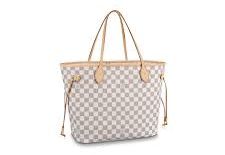Louis Vuitton Malletier, commonly known as Louis Vuitton (LV) is a French high-end luxury fashion house. The company was founded in 1854 by Louis Vuitton and is particularly known for its famous bags. One of the patterns often used on its bags is a Damier Azur pattern (or "chequerboard" pattern) represented as follows:

Louis Vuitton Damier Azur was first introduced in 2006 and is probably known by all fashion lovers.
The background of the case
LV filed an international application No 986207 for "![]() " with designation of, among the others,
the EU. The mark was registered on 4 November 2008 for the
following goods in class 18: "boxes of leather or
imitation leather, trunks, suitcases, traveling sets (leatherware),
traveling bags, luggage, garment bags for travel, hat boxes of
leather, vanity cases (not fitted), toiletry bags (empty),
backpacks, satchels, handbags, beach bags, shopping bags,
shoulder-strap bags, carrier bags, shoulder bags, waist bags,
purses, attaché cases, briefcases (leatherware), school
bags, document holders, clutch bags, wallets, change purses, key
cases, card cases (wallets), umbrellas, sunshades."
" with designation of, among the others,
the EU. The mark was registered on 4 November 2008 for the
following goods in class 18: "boxes of leather or
imitation leather, trunks, suitcases, traveling sets (leatherware),
traveling bags, luggage, garment bags for travel, hat boxes of
leather, vanity cases (not fitted), toiletry bags (empty),
backpacks, satchels, handbags, beach bags, shopping bags,
shoulder-strap bags, carrier bags, shoulder bags, waist bags,
purses, attaché cases, briefcases (leatherware), school
bags, document holders, clutch bags, wallets, change purses, key
cases, card cases (wallets), umbrellas, sunshades."
On the 25 June 2015, Mr. Norbert Wisniewski filed an application with the EUIPO for a declaration of invalidity of the EU designation of the above-mentioned trade mark of LV.
The Cancellation Division of the EUIPO further granted the application for a declaration of invalidity on the basis of Article 7(1)(b) of the Regulation, which holds that trade marks which are devoid of any distinctive character cannot be registered.
The decision was further appealed to the Board of Appeal of the EUIPO (BoA) and a decision of 22 November 2018 dismissed the appeal on the basis that the pattern was inherently devoid of distinctive character and that LV had not demonstrated that the pattern had acquired distinctive character through use.
Further, LV filed an appeal before the General Court (GC). The GC (T‑105/19) concluded that the BoA had been right in ruling out inherent distinctiveness of the mark at issue. However, it had not evaluated properly the evidence submitted by LV in support of a claim of acquired distinctiveness in the EU in relation to class 18. Consequently, the matter came back to the BoA.
Judgement of the GC in case T‑105/19 from 10 June 2020:
Click here
In 2021, the BoA found out that the evidence provided by LV was not sufficient to prove the acquired distinctiveness. In particular, the evidence in relation to Estonia, Lithuania, Latvia, Slovakia, Slovenia and Bulgaria was missing.
Decision of the Board of Appeal in case R 1307/2020-5 from 25 February 2021
Click here
Finally, on October 19, 2022, the GC (T-275/21) has upheld the BoA´s decision which stated that according to Article 7(1)(b)EUTMR the mark of Louis Vuitton was inherently devoid of distinctive character for the goods in Class 18. Additionally, LV had not demonstrated that the contested trade mark had acquired distinctive character through use according to Article 7(3)(b)EUTMR.
Judgement of the GC in case T‑275/21 from 19 October 2022:
Click here
Judgement of the GC
The general rule is that a mark which is devoid of distinctive character in all Member States, can only be registered if it has been proved to have acquired distinctive character through use throughout the territory of the European Union (para. 24) and not only a substantial part or the majority of such a territory (para. 28).
As confirmed by the GC, this does not mean that proof has to be provided in relation to each of the EU-27 Member States: holding otherwise would be "unreasonable" (para. 25). Nevertheless, the missing evidence in relation to Estonia, Lithuania, Latvia, Slovakia, Slovenia and Bulgaria meant that acquired distinctiveness was not considered to be sufficiently proved.
It was also pointed out that it is very typical that for certain goods or services, economic operators tend to group several Member States together in the same distribution network. This means that they are treating those Member States, especially for marketing strategy purposes, as if they were one and the same national market. In these situations, the evidence of use is likely to be relevant for all the Member States concerned and as such can be taken into consideration as valuable evidence.
A similar situation may appear due to a geographic, cultural or linguistic proximity between two Member States. It means that the relevant public of one state may be aware of the products and services in the other state (para. 27). Also, it is true that advertising campaigns may target several Member States or be broadcast simultaneously in the media zone of those Member States (para. 65).
On the other hand, the GC does not consider as a relevant the arguments about the possibility that the relevant public in the Member States concerned may have been exposed to those advertising campaigns or exposed to the magazines published elsewhere, for example during travel to Member States where they had been distributed (para. 70). What´s more, Vuitton's argument that in the EU, "consumers engage in homogeneous behaviour as regards luxury brands, particularly because they travel and use the internet regularly" (para. 135) was also rejected, as being "too general in nature".
The court also dismissed the claim that Latvia and Lithuania would be geographically and culturally close to Poland and Sweden while Bulgaria, Slovakia and Slovenia would be close to Romania (paras. 136-137). As in the view of the court, the evidence provided was not enough to confirm it.
The GC also provides in this judgement a useful guideline on the internet evidence in assessing distinctive character acquired through use. It states that for example, the internet pages on which a mark in question is displayed, promoted or marketed may be a valuable evidence for such proceeding. However, to be relevant for that purpose, this type of evidence must demonstrate that it targets or is consulted by a significant part of the relevant public in the Member States in which the mark is devoid of inherent distinctiveness (para. 80). For that reason, account should be taken, in particular, of the top-level domains of the websites in question, their language and their content (para. 81), including in particular traffic analysis reports (para. 82). On the other hand, the fact that a website on which the mark at issue was promoted is accessible from some Member States is not sufficient to prove that a significant part of the relevant public in those Member States has been exposed to it (para. 84).
Additionally, in this judgement, the GC clarifies the question of the relevant public´s awareness of the luxury brands. It says that for this particular sector, it is not necessarily proportionate to the volume of sales of the goods bearing the marks. Even consumers in the general public who are not able to buy luxury goods are exposed to them and familiar with them. Also, the fact that a trade mark is among the most well-known luxury brands may therefore, in principle, be relevant for the purposes of assessing the general public's perception of that mark (paras. 47, 60, 126).
Comments
This judgement is definitely an important judgment for all luxury brands. But it is also crucial for any applicant who would like to file its trade mark and claim acquired distinctiveness through use.
We can also treat it as a further guideline on how to prepare the evidence which will support such claims, so that they are further accepted by the EUIPO. However, it is also confirming that claiming acquired distinctiveness through use at the EU level is not the easiest one. This includes both applying for a trade mark based on acquired distinctiveness and of defending the mark in the case of an application with the EUIPO for a declaration of invalidity being filed.
Originally published 22 December 2022
The content of this article is intended to provide a general guide to the subject matter. Specialist advice should be sought about your specific circumstances.
[View Source]

